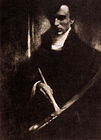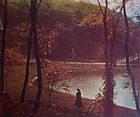
Edward Steichen
Edward Jean Steichen (March 27, 1879 – March 25, 1973) was a Luxembourgish American photographer, painter, and curator, renowned as one of the most prolific and influential figures in the history of photography.[1]
Edward Steichen
March 25, 1973 (aged 93)
Luxembourg by birth; United States from 1900
Mary Steichen Calderone
Charlotte "Kate" Rodina Steichen
Lilian Steichen (sister)
Carl Sandburg (brother-in-law)
Steichen was credited with transforming photography into an art form.[2] His photographs appeared in Alfred Stieglitz's groundbreaking magazine Camera Work more often than anyone else during its publication run from 1903 to 1917. Stieglitz hailed him as "the greatest photographer that ever lived".[3][4]
As a pioneer of fashion photography, Steichen's gown images for the magazine Art et Décoration in 1911 were the first modern fashion photographs to be published. From 1923 to 1938, Steichen served as chief photographer for the Condé Nast magazines Vogue and Vanity Fair, while also working for many advertising agencies, including J. Walter Thompson. During these years, Steichen was regarded as the most popular and highest-paid photographer in the world.[5]
After the United States' entry into World War II, Steichen was invited by the United States Navy to serve as Director of the Naval Aviation Photographic Unit.[6] In 1944, he directed the war documentary The Fighting Lady, which won the Academy Award for Best Documentary Feature at the 17th Academy Awards.
From 1947 to 1961, Steichen served as Director of the Department of Photography at New York's Museum of Modern Art. While there, he curated and assembled exhibits including The Family of Man, which was seen by nine million people. In 2003, the Family of Man photographic collection was added to UNESCO's Memory of the World Register in recognition of its historical value.[7]
In February 2006, a print of Steichen's early pictorialist photograph, The Pond—Moonlight (1904), sold for US$2.9 million—at the time, the highest price ever paid for a photograph at auction.[8] A print of another photograph of the same style, The Flatiron (1904), became the second most expensive photograph ever on November 8, 2022, when it was sold for $12,000,000, at Christie's New York – well above the original estimate of $2,000,000-$3,000,000.[9]
Later life[edit]
On December 6, 1963, Steichen was presented with the Presidential Medal of Freedom by U.S. President Lyndon B. Johnson.[69]
Though then 88 years old and unable to attend in person, in 1967 Steichen, as a still-active member of the copyright committee of the American Society of Magazine Photographers, wrote a submission to the U.S. Senate hearings to support copyright law revisions, requesting that "this young giant among the visual arts be given equal rights by having its peculiar problems taken into account."[70]
In 1968, the Edward Steichen Archive was established in MoMA's Department of Photography. The Museum's then-Director René d'Harnoncourt declared that its function was to "amplify and clarify the meaning of Steichen's contribution to the art of photography, and to modern art generally."[28] Creator of the Archive was Grace M. Mayer, who in 1959 started her career as an assistant to the director, Steichen, and who became Curator of Photography in 1962, retiring in 1968. Mayer returned after her retirement to serve in a voluntary capacity as Curator of the Edward Steichen Archive until the mid-1980s to source materials by, about, and related to Steichen. Her detailed card catalogs are housed in the Museum's Grace M. Mayer Papers.[71]
Steichen's 90th birthday was marked with a dinner gathering of photographers, editors, writers, and museum professionals at the Plaza Hotel in 1969. The event was hosted by MoMA trustee Henry Allen Moe, and U.S. Camera magazine publisher Tom Maloney.[28]
In 1970, an evening show was presented in Arles during The Rencontres d'Arles festival: "Edward Steichen, photographe" by Martin Boschet.
Steichen bought a farm that he called Umpawaug in 1928, just outside West Redding, Connecticut.[72] He lived there until his death on March 25, 1973, two days before his 94th birthday.[73] After his death, Steichen's farm was made into a park, known as Topstone Park.[74] As of 2018, Topstone Park was open seasonally.[75]
In 1974, Steichen was posthumously inducted into the International Photography Hall of Fame and Museum.[3]
Personal life[edit]
Steichen married Clara E. Smith (1875–1952) in 1903. They had two daughters, Mary Rose Steichen (1904-1998) and Charlotte "Kate" Rodina Steichen (1908-1988). In 1914, Clara accused her husband of having an affair with artist Marion H. Beckett, who was staying with them in France. The Steichens left France just ahead of invading German troops. In 1915, Clara Steichen returned to France with her daughter Kate, staying in their house in the Marne in spite of the war. Steichen returned to France with the Photography Division of the American Army Signal Corps in 1917, whereupon Clara returned to the United States. In 1919, Clara Steichen sued Marion Beckett for having an affair with her husband, but was unable to prove her claims.[79][80] Clara and Edward Steichen eventually divorced in 1922.
Steichen married Dana Desboro Glover in 1923. She died of leukemia in 1957.
In 1960, aged 80, Steichen married 27-year-old Joanna Taub and remained married to her until his death, two days before his 94th birthday. Joanna Steichen died on July 24, 2010, in Montauk, New York, aged 77.[81]














